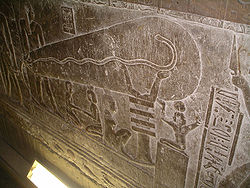
Dendera light
Encyclopedia

Dendera Temple complex
Dendera Temple complex, . located about 2.5 km south-east of Dendera, Egypt. It is one of the best-preserved temple complexes in Egypt...
located in Egypt
Egypt
Egypt , officially the Arab Republic of Egypt, Arabic: , is a country mainly in North Africa, with the Sinai Peninsula forming a land bridge in Southwest Asia. Egypt is thus a transcontinental country, and a major power in Africa, the Mediterranean Basin, the Middle East and the Muslim world...
. The sculpture became notable among fringe historians because of the resemblance of the motifs to some modern electical lighting systems.
Mainstream Egyptologists take the view that it is a typical set of symbolic images from Egyptian mythology.
Mainstream view
The view of Egyptologists is that the relief is a mythologicalEgyptian mythology
Ancient Egyptian religion was a complex system of polytheistic beliefs and rituals which were an integral part of ancient Egyptian society. It centered on the Egyptians' interaction with a multitude of deities who were believed to be present in, and in control of, the forces and elements of nature...
depiction of a djed
Djed
The djed symbol is a pillar-like ancient Egyptian symbol representing stability. It has been interpreted as the backbone of the Egyptian god Osiris, especially in the form Banebdjedet . Djedu is the Egyptian name for Busiris, a centre of the cult of Osiris...
pillar and a lotus
Nymphaea caerulea
Nymphaea caerulea, also known as the Blue Egyptian water lily or sacred blue lily, is a water-lily in the genus Nymphaea.-Distribution:Its original habitat may have been along the Nile and other locations in East Africa...
flower, spawning a snake within, representing aspects of Egyptian mythology
Egyptian mythology
Ancient Egyptian religion was a complex system of polytheistic beliefs and rituals which were an integral part of ancient Egyptian society. It centered on the Egyptians' interaction with a multitude of deities who were believed to be present in, and in control of, the forces and elements of nature...
. The Djed pillar is a symbol of stability which is also interpreted as the backbone of the god Osiris. In the carvings the four horizontal lines forming the capital of the djed are supplemented by human arms stretching out, as if the djed were a backbone. The arms hold up the snake within the lotus flower. The snakes coming from the lotus symbolize fertility, linked to the annual Nile
Nile
The Nile is a major north-flowing river in North Africa, generally regarded as the longest river in the world. It is long. It runs through the ten countries of Sudan, South Sudan, Burundi, Rwanda, Democratic Republic of the Congo, Tanzania, Kenya, Ethiopia, Uganda and Egypt.The Nile has two major...
flood.
Fringe view
In contrast to the mainstream interpretation, there is a fringe hypothesisFringe science
Fringe science is scientific inquiry in an established field of study that departs significantly from mainstream or orthodox theories, and is classified in the "fringes" of a credible mainstream academic discipline....
according to which the reliefs depict Ancient Egyptian electrical technology, based on comparison to similar modern devices (such as Geissler tube
Geissler tube
A Geissler tube is an early gas discharge tube used to demonstrate the principles of electrical glow discharge. The tube was invented by the German physicist and glassblower Heinrich Geissler in 1857...
s, Crookes tube
Crookes tube
A Crookes tube is an early experimental electrical discharge tube, invented by English physicist William Crookes and others around 1869-1875, in which cathode rays, that is electrons, were discovered....
s, and arc lamp
Arc lamp
"Arc lamp" or "arc light" is the general term for a class of lamps that produce light by an electric arc . The lamp consists of two electrodes, first made from carbon but typically made today of tungsten, which are separated by a gas...
s). J. N. Lockyer
Joseph Norman Lockyer
Sir Joseph Norman Lockyer, FRS , known simply as Norman Lockyer, was an English scientist and astronomer. Along with the French scientist Pierre Janssen he is credited with discovering the gas helium...
's passing reference to a colleague's humorous suggestion that electric lamps would explain the absence of lampblack deposits in the tombs has sometimes been forwarded as an argument supporting this particular interpretation (another argument being made is the use of a system of reflective mirrors).
Proponents of this interpretation have also used a text referring to "high poles covered with copper plates" to argue this but Dr. Bolko Stern has written in detail explaining why the copper covered tops of poles (which were lower than the associated pylons) do not relate to electricity or lightning, pointing out that no evidence of anything used to manipulate electricity had been found in Egypt and that this was a magical and not a technical installation.
See also
- AnachronismAnachronismAn anachronism—from the Greek ανά and χρόνος — is an inconsistency in some chronological arrangement, especially a chronological misplacing of persons, events, objects, or customs in regard to each other...
- Baghdad BatteryBaghdad BatteryThe Baghdad Battery, sometimes referred to as the Parthian Battery, is the common name for a number of artifacts created in Mesopotamia, during the dynasties of Parthian or Sassanid period , and probably discovered in 1936 in the village of Khuyut Rabbou'a, near Baghdad, Iraq...
- Egyptian mythologyEgyptian mythologyAncient Egyptian religion was a complex system of polytheistic beliefs and rituals which were an integral part of ancient Egyptian society. It centered on the Egyptians' interaction with a multitude of deities who were believed to be present in, and in control of, the forces and elements of nature...
- Pseudoarcheology
- Out-of-place artifact
External links
- The Dendera Reliefs, Catchpenny Mysteries.
- Frank Dörnenburg, Electric lights in Egypt?. 2004. (ed. An analysis of how the Egyptians didn't have electricity).

